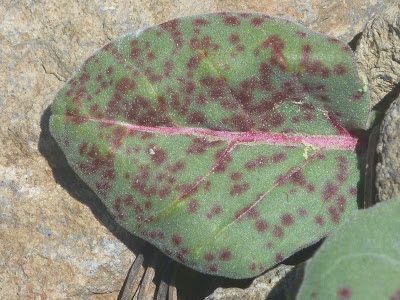 Woody-fruited evening primroses (Oenothera xylocarpa) are rare on
dry and sandy flats and slopes in northeastern Tahoe at mid and high elevation [1].
The shown parts belong to plants that were found growing in forest openings—often in association with lupines—at high elevation along the
Tahoe Rim Trail (TRT) between Relay Peak and the Slab Cliffs, in the Carson Range northeast of Lake Tahoe in northwest Nevada.
Woody-fruited evening primroses (Oenothera xylocarpa) are rare on
dry and sandy flats and slopes in northeastern Tahoe at mid and high elevation [1].
The shown parts belong to plants that were found growing in forest openings—often in association with lupines—at high elevation along the
Tahoe Rim Trail (TRT) between Relay Peak and the Slab Cliffs, in the Carson Range northeast of Lake Tahoe in northwest Nevada. The small plants bear large yellow flowers. The showy flowers have four petals each. They are short-lived, often lasting only for a night. They then turn scarlet, bend and finally lay down onto the ground as if they want to fall asleep. A central plant stem is missing, but each leave is attached to a rhubarb-red petiole, which visually continues on as the main axis through the leaf blade. The typically flat and dense rosette of leaves builds a circular pillow arrangement for the aging flowers. Particularly interesting are the many deep blood-red spots—on average lentil-sized and blurry-edged—that spread out over these basal leaves.
The literature on this rare evening-primrose species, whose common name is also written as woodyfruit evening primrose [2-4], is sparse. Based on a map showing the distribution of different Oenothera species in western North America, O. xylocarpa is found in three locations including northeast Tahoe in Nevada and two High Sierra areas further south in California [5]. More detailed, Warren L. Wagner writes (on pages 334 and 335 in [5]):
Oenothera xylocarpa has a presumably relictual distribution in the Sierra Nevada of California and Nevada, at 2250-3050 m. It is restricted to granitic gravels, sand, or pumice in forests of Pinus jefferyi or Pinus contorta subsp. murrayana / Abies magnifica. It must have been more widespread at one time but now occurs in three disjunct areas: 1) Mount Rose, Nevada; 2) southern Sierra Nevada, Mono County from Crestview to Casa Diablo; and 3) southern Sierra Nevada, primarily Inyo County, Big Whitney Meadows to Volcano Meadows and Casa Vieja. Oenothera xylocarpa may have been more widespread in the past and subsequently with episodes of mountain building and cooling and drying of the climate, populations of O. xylocarpa have become progressively more restricted to marginal substrates not inhabited by other species. Now it occurs only on very porous substrates, and has a disjunct range corresponding to the distribution of those substrates.
Keywords: wildflowers, evening primrose family (Onagraceae), porous soil, Carson Range, Reno-Tahoe.
References and more to explore
[1] Laird R. Blackwell: Tahoe Wildflowers • A Month-by-Month Guide to Wildflowers in the Tahoe Basin and Surrounding Areas. A Falcon Guide, Morris Book Publishing, LLC, 2007; page 91.
[2] Encyclopedia of Life: Oenothera xylocarpa [http://eol.org/pages/582890/overview].
[3] USDA PLANTS Profile: Oenothera xylocarpa Coville, woodyfruit evening primrose [plants.usda.gov/java/profile?symbol=OEXY].
[4] Jepson Manual: Onagraceae [ucjeps.berkeley.edu/cgi-bin/get_JM_treatment.pl?5263,5471,5501].
[5] Warren L. Wagner: Systematics of Oenothera Sections Contortae, Eremia, and Ravenia (Onagraceae). Systematic Botany 2005, 30 (2), pp. 332-335 [si-pddr.si.edu/dspace/bitstream/10088/7592/1/bot_Wagner_2005_Oenothera_Pachylophus_et_a_HI.pdf].
















No comments:
Post a Comment